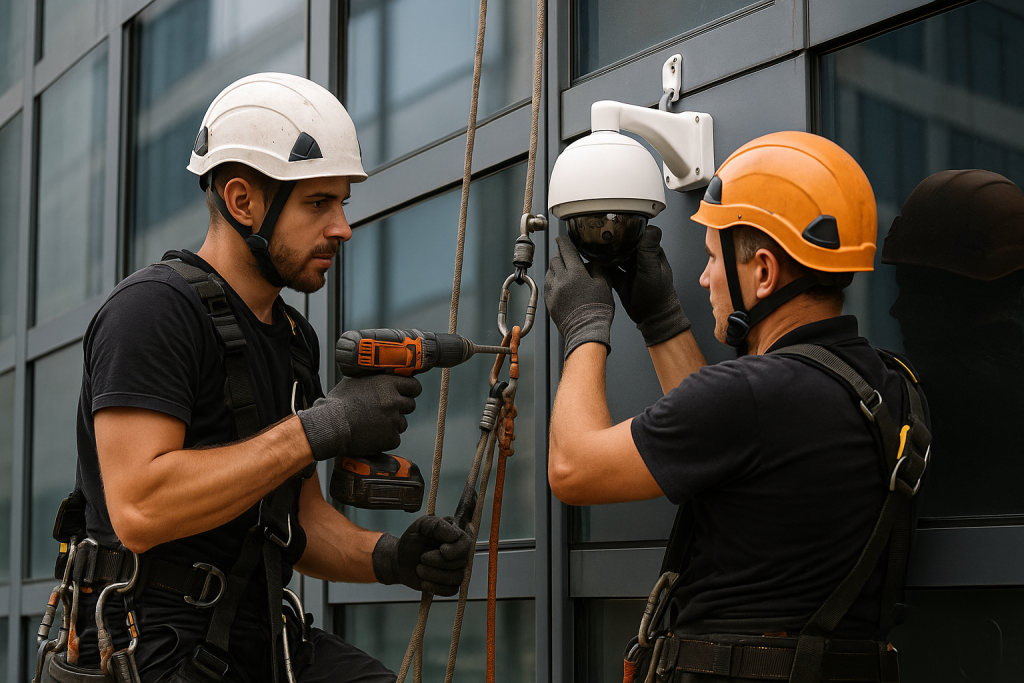Installing cameras at height: why climbers are the best choice for installing surveillance systems

Surveillance systems have become an integral part of security in modern cities and businesses. Cameras are placed on building facades, lighting poles, shopping center roofs, warehouses, and offices. The higher the installation point, the greater the view, but at the same time, the more difficult the installation becomes.
Operating conditions create additional complexity—roofing materials can be slippery or fragile, and facades can be fragile and unstable under load. In large cities, cameras are often mounted on multi-story buildings, where the use of equipment is limited by dense development or engineering communications. Installing cameras independently in such conditions poses a risk to both personnel and equipment. That is why it is advisable to entrust the installation of cameras at height to industrial climbers who have the proper training and technical means to perform the work safely.
The role of climbers in installing cameras
Industrial climbers specialize in high-altitude work where traditional methods are impossible or ineffective. Their skills allow them to reach the most difficult areas of a building, ensure the safe lifting of equipment, and install cameras with high precision. This is especially relevant for large office complexes, warehouses, shopping and entertainment centers, and multi-story buildings.
Industrial climbers do not require bulky equipment: rope systems and specialized tools are sufficient. This significantly reduces preparation time, lowers the cost of work, and allows for a quick response to customer needs. Thanks to their mobility and versatility, industrial climbers have become the optimal choice for installing surveillance systems at height.
Technical equipment and safety during work
Installing cameras at height requires the use of proven equipment that guarantees the safety of personnel and the integrity of the equipment. Industrial climbers use block systems to move loads, manual and electric winches for controlled lifting of equipment, pulleys to reduce load, and safety kits that include ropes, carabiners, and locking devices.
Safety organization begins with an assessment of the facility: attachment points are checked, optimal lifting routes are selected, and the possible impact of wind loads is determined. All work is performed in compliance with international standards for work at height. This reduces the risk of accidents and ensures long-term operation of the equipment. In addition, the correctness of cable routing and the tightness of connections are checked, as the cameras must operate stably in all weather conditions.
Stages of installing video surveillance cameras:
- Preliminary inspection of the facility and determination of locations for camera installation.
- Planning the route of ascent and selecting the necessary equipment.
- Installation of safety systems and preparation of work points.
- Lifting equipment to height and securing it in designated locations.
- Connecting cameras to the surveillance system and checking their performance.
Advantages of industrial climbing for businesses and private properties
The involvement of industrial climbers in the installation of cameras has a number of undeniable advantages:
- the ability to install cameras in hard-to-reach places;
- speed of work without the need for bulky equipment;
- savings on the cost of renting lifts or scaffolding;
- safety for personnel and equipment;
- versatility: work on roofs, facades, poles, and in industrial areas;
- flexibility in performing tasks of varying complexity.
For businesses, this means reliable control of office, warehouse, and retail premises without unnecessary costs. For private customers, it means confidence in the security of their homes, the effectiveness of video surveillance systems, and no risk of damage to facades or roofs. It is also worth noting that industrial climbers have experience working with various types of equipment, from standard IP cameras to complex systems with rotating mechanisms and thermal imagers. This makes them versatile specialists capable of implementing projects of any complexity.
Installing cameras at height is a task that requires a combination of professional skills, special equipment, and strict adherence to safety regulations. Industrial climbers combine all these components, ensuring high-quality installation of surveillance systems on any type of facility. They are able to work in conditions of limited access, difficult terrain, or dense buildings, guaranteeing accuracy and safety. Thanks to their mobility, experience, and responsibility, climbers remain the best choice for businesses and private customers who want reliable control and a high level of security.
Interesting articles:
How climbers assist in the assembly and dismantling of structures at height: technical aspects of lifting loads
Lifting loads for installing solar panels on roofs: why climbers are the best specialists for this work
